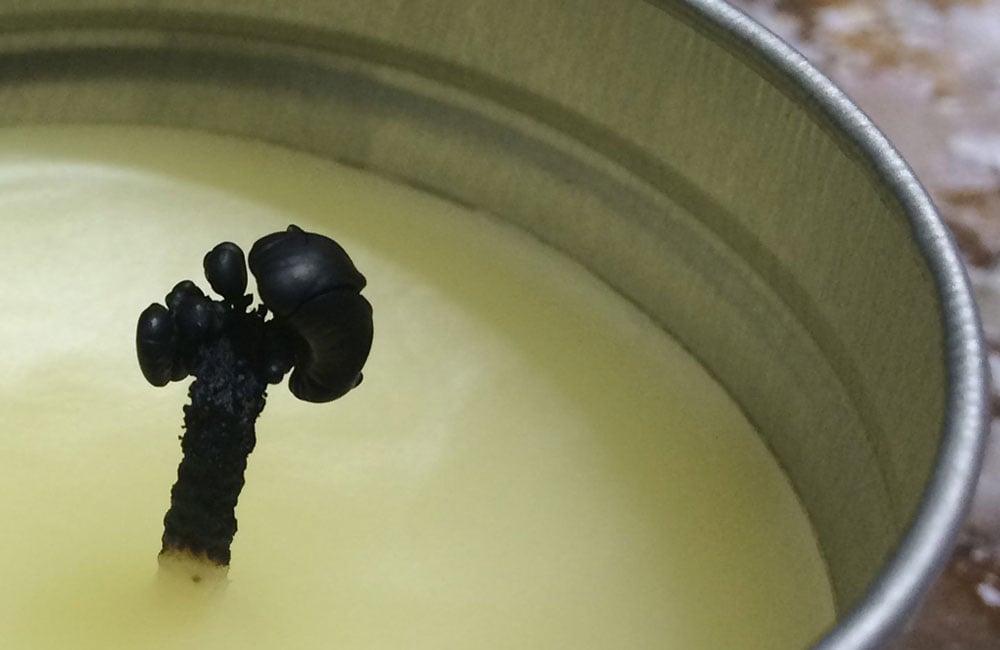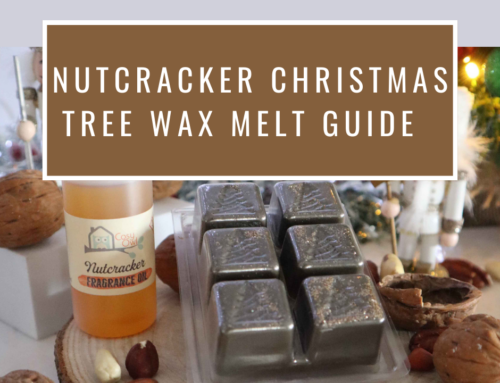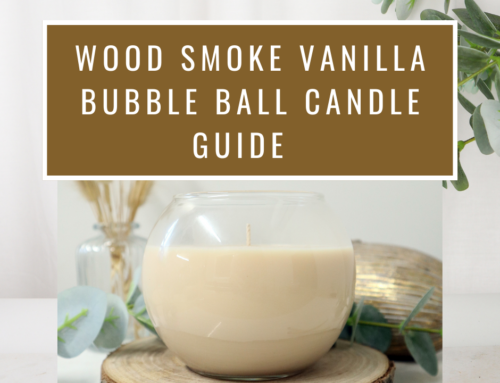Are you experiencing issues with your homemade candle, such as tunnelling wax or the wick generating smoke? We have put together a troubleshooting candle making problems guide with key terms and issues explained.
Below is a list of the most common problems that arise from candle making. Even the best among us can experience these issues occasionally. Always be patient with your candle making and enjoy the hobby, becoming more adapt as you become more experienced. Sometimes there is little you can do to rectify a problem after the candle has solidified; we always recommend telling your family and friends that what occurred was deliberate and very cleverly done.
Bubbling effect
If you find a bubbling effect in your finished candle, this could be because the wax is not within the recommended temperature range or the wax has been disturbed during the cooling process.
Tunnelling
I have a ‘tunnelling’ effect with my candle where the outside of the candle does not melt as quickly as the inside. Eventually the wick burns out resulting in half the wax left over. This is simply caused by having too small a wick. Try the next size up when making this size of candle in the future. Check the size of the wick needed (based on the diameter of the candle) using the information available in our candle wick section – when selecting a particular wick, click on the ‘Candle Diameter’ tab.
Sink holes
Sink holes (also known as ‘wells’) can appear at the top of the candle during the cooling process. This can happen for many reasons and is very common. As with the bubbling effect the chance of this happening can be reduced by making sure the wax is at the right temperature when pouring. To resolve this, simply add more hot wax (at the appropriate temperature) to fill in the holes. You must make sure that the candle has fully solidified before adding any more wax. Allow this added wax to solidify before removing the candle from the mould/container.
Another remedy to this issue, which occasionally can work is if you preheat the container prior to pouring the wax.
Smokey wick
The wick is generating smoke. This can arise for a number of reasons. A common cause is if the wick is too long at the top of the candle; blow out the candle and reduce the length of the wick to about 1cm. Another reason is if the wick used is significantly too large in relation to the diameter of the candle. This smoking effect can also occur if too much of any additive has been used within your candle wax mix – simply reduce the quantity used. Also avoid placing the candle where there might be a draft.
Extinguishing wick
The candle keeps going out. Try priming the candle wick by coating it with wax (giving the wick time to absorb the wax coating) and allowing that to solidify before adding your molten wax. This can also happen if using a candle wick which is too thin for the diameter of the candle. Another reason for this relates to the type and quality of any candle dye added to the mix. At Cosy Owl, we do not sell dyes which contain any pigment; it is this that can contaminate the candle wick as it burns down.
Mushrooming wick
The wick seems to be ‘mushrooming’. This is where the burnt wick starts to twist and curl, often with parts of unburnt wick still attached. This is due to unwanted carbon build-up and is commonly a result of a candle wick being too large in size for the diameter of the candle.
Wick movement
The wick has moved during the cooling process. This can happen if the wick has not been pulled taut from the outset of the cooling process.
Cracking
The candle was cracked when I removed it from the mold. This occurs when the candle has been cooled too quickly. Candles should generally be allowed to cool in moderate room temperature. Do not place the candle in the refrigerator or freezer in an attempt to speed up the process of the wax solidifying. The top of the candle is cracked. This can be remedied by using a hairdryer to slightly melt the surface of the candle until the cracks disappear.
Fragrance oil seeping
I have fragrance oil seeping from the candle. The most common cause of this is the use of too much fragrance oil mixed in with the molten candle wax. If this becomes a regular issue, because of the amount of fragrance oil you wish to use, the problem can be addressed by incorporating a hardening solution into the molten wax mix. Although we cannot recommend a particular brand, an example of such an agent is Vybar.
Wax caught fire
The wax has caught fire in the pan! Obviously, the temperature of the wax was significantly above that required. Make sure you use a wax thermometer and this should not happen. Many people think wax by itself cannot catch fire. They’re wrong. In such an event use a water drenched t-towel or a fire blanket to cover the pan; after a few moments, carefully remove the pan from the heat. If using a fire extinguisher (if things get really serious) do not apply water, preferably use powder.
Cleaning
I have wax all over the surface of my counter. Use a plastic spatula or ladle to gently scrape the wax off the surface. Once the majority has been removed, use a reasonably warm disposable cloth (material or preferably paper) to remove what is left. Dispose of safely.
I have wax over my clothes. To remove wax from clothes, firstly do not scrape off the wax or you will damage the fabric. Place the clothing on an ironing board with a few layers of paper towel beneath the material effected. Now place a couple of paper towels over the material with wax deposit and use an iron to remove the wax. The wax will be lifted off the clothing and be absorbed by the paper towel. Set the iron to a low to medium temperature. If you have spilt any wax on a carpet, you can do more or less the same thing to remove it – just be very careful, set the iron to a low temperature first and only increase it, if you are sure it will not damage the fabric of the carpet. Do not allow the iron to rest on the surface of the material/carpet – keep the iron moving.
Dye issues
The colour is starting to fade. Almost all coloured candles can start to fade if placed in direct sunlight for proglonged periods of time. While it is easy to say add more dye when making the candle, you can end up with a candle that is more expensive to make and perhaps of a stronger colour than wanted. A way around fading is to store the candle in a cupboard or dark area of a room. Professionals will use a UV inhibitor to extend the period during which the candle will maintain its colour. At Cosy Owl we only supply high quality dyes – other lessor quality candle dyes don’t allow the candle to hold its colour for as long.
I can see dye spots on the surface and/or sides of my candle. This can occur when the dye has not been fully dissolved in the molten wax. Make sure you stir thoroughly before pouring into your container.
Find our full list of FAQ’s here.
Find us on social media:










Leave A Comment